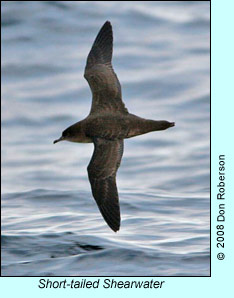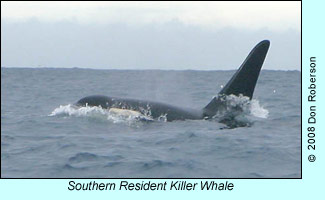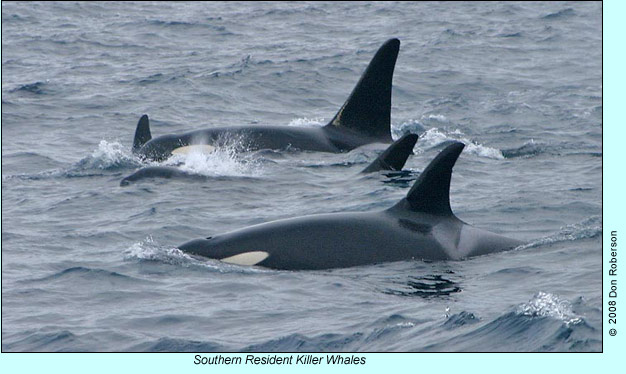Sunday January 27, 2008 3 hour tour
- 7 a.m. to 10 a.m.
I once asked one of the whale watch skippers out of Monterey what
weather forecasting he thought was best. His words were, "If I paid
attention to the weather reports I'd never go to work."
The more I read weather forecasts the more skeptical I become of their
accuracy, enough said.
The weather according to the prognosticators looked bad. I got calls
and emails wondering if the trip was going to be cancelled. Some folks
just cancelled, others just didn't show up.
I heard the wind gust throughout the night but on the drive down to
Monterey the wind appeared to be laying down. The forecast rain and
wind were absent. Go figure.
Leaving the harbor at 7 am we found a male HARLEQUIN DUCK next
to the bell buoy. The seas were moderate and we were out of the wind
as long as we stayed inside the bay. Moving along we were finding
lots of WESTERN and EARED GREBES but only a single HORNED
GREBE. There were both COMMON and PACIFIC LOONS.
A few RED PHALAROPES scattered about.
At the back of the boat Todd Easterla was dispensing the popcorn off
the stern and attracting a nice variety of gulls. A MEW GULL
was a bit of a surprise and a few THAYER'S and BONAPARTE'S
GULLS were fun to see. In total we ended up with 8 gull species
for the day.
 Rather
than doing the typical 3-hour whale watch route out past Pt. Pinos
we headed for the edge of the Monterey Sea Canyon in the heart of
the bay. From a distance there appeared to be quite a bit of bird
activity but we weren't sure why. As we grew closer a SHORT-TAILED
SHEARWATER came in to investigate why the gulls were following
us. Right away we found a second STSH; we tallied 3 for the day. Rather
than doing the typical 3-hour whale watch route out past Pt. Pinos
we headed for the edge of the Monterey Sea Canyon in the heart of
the bay. From a distance there appeared to be quite a bit of bird
activity but we weren't sure why. As we grew closer a SHORT-TAILED
SHEARWATER came in to investigate why the gulls were following
us. Right away we found a second STSH; we tallied 3 for the day.
Blows off the bow called our attention to three GRAY WHALES
crossing the bay en route to Mexico. We stumble across a bottling
ELEPHANT SEAL bobbing at the surface.
We had seen several COMMON MURRES and as we moved over the
canyon we began seeing lots of RHINOCEROS AUKLETS and in their
midst a single BLACK-VENTED SHEARWATER. Off of the stern Todd
called out PINK-FOOTED SHEARWATER, but wait, there are two!
 We
are trying to figure out what is attracting all the gulls to the area
when we spot some marine mammals. We turn in that direction and come
upon a large pod of KILLER WHALES! They seem to be spread out all
over but one group of a dozen or so comes in quite close to our boat,
and when they do Richard gets a good look at their saddle patches,
which indicate that they are SOUTHERN RESIDENT KILLER WHALES. We estimate
there are almost 40 of them. We
are trying to figure out what is attracting all the gulls to the area
when we spot some marine mammals. We turn in that direction and come
upon a large pod of KILLER WHALES! They seem to be spread out all
over but one group of a dozen or so comes in quite close to our boat,
and when they do Richard gets a good look at their saddle patches,
which indicate that they are SOUTHERN RESIDENT KILLER WHALES. We estimate
there are almost 40 of them.
This is only the fourth time that this type of Killer Whale has been
seen in the Monterey Bay. These are from one of the pods most commonly
seen in the Puget Sound area in the summer and fall. They are 1,000
miles outside their normal range.
Monterey Killer Whale researcher Nancy Black has written:
|
"Killer whale populations are not all the same. In the eastern
North Pacific there are three distinct types, 'residents', 'transients',
and 'offshores'. Each population is genetically distinct, specializes
on different prey, exhibits different social and association
patterns, has different vocal dialects, and frequents or travels
different areas, some overlapping.
- The 'residents' usually are found over a limited area and
have the tightest social structure of any marine mammal, living
in close-knit family groups. These whales feed mainly on fish
and can be very vocal. This whale type was thought to reside
only in the Pacific Northwest from Washington to Alaska.
- The 'transient' type of killer whale is truly a top predator,
consuming mostly marine mammals, from seals to large baleen
whales. This type covers long distances, often travels in
small groups, and is relatively quiet vocally.
- The 'offshores' are a lesser-known group, traveling long
distances in large groups (often 50 or more) and probably
feeding on fish and squid.
The trained observer at sea can distinguish all these types
by size, markings, and behavior."
|
See entire article at: https://www.montereybaywhalewatch.com/feat0002.htm

See live action of the Southern Resident Killer Whales in a video
taken by Roger Wolfe.
Typically in Monterey Bay waters we see "transient type" Killer Whales.
Everyone on board is thrilled by this unusual sighting.
As we head for home, approaching the jetty we see a single wintering
PIGEON GUILLEMOT. On our way back to our own dock we find a
MARBLED MURRELET just inside the jetty and a pair of HARLEQUIN
DUCKS.
Our second cruise of the day, from 10 a.m. to 1 p.m., was led by Tim
Amaral. On this cruise they found the Resident Killer Whales again
and also saw 2 PINK-FOOTED SHEARWATERS. Other than that it
was the usual suspects.
Roger Wolfe for Monterey
Seabirds

|
